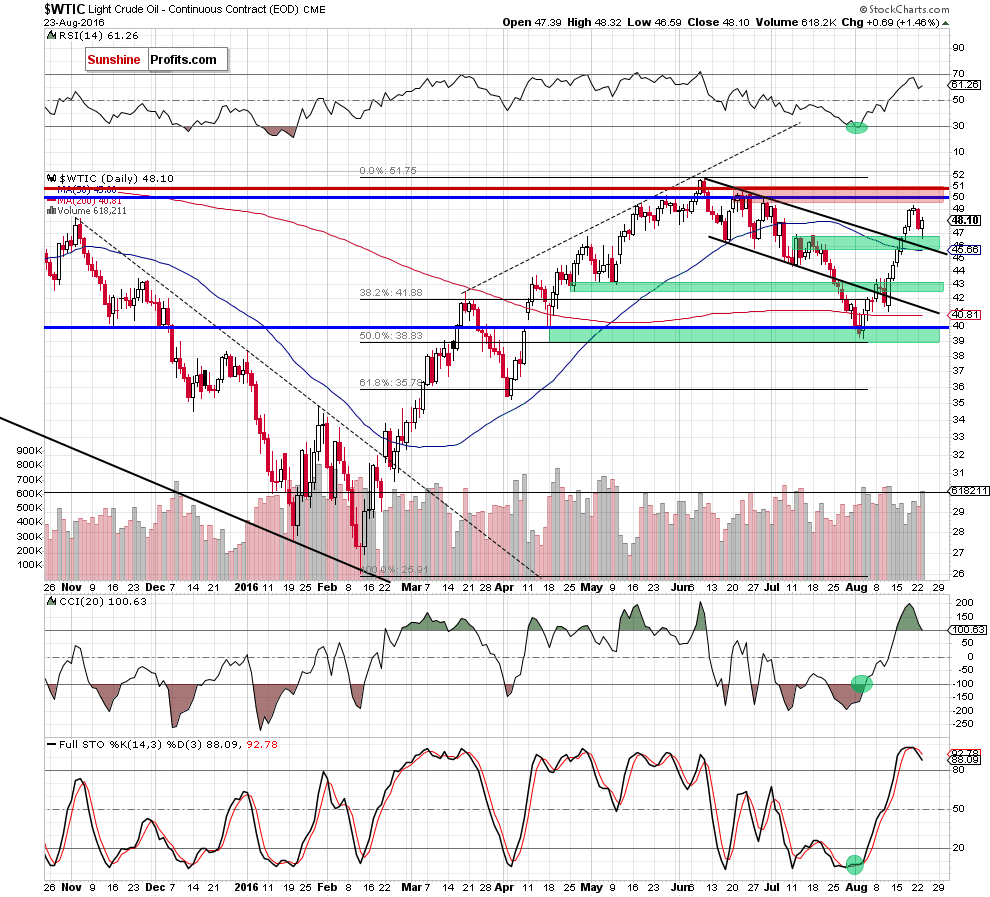Trading position (short-term; our opinion): No positions are justified from the risk/reward perspective.
Yesterday, crude oil declined and touched the upper part of the support area and the reversal took place on big volume. Is the short-term bottom in? It’s impossible to reply to this question without analyzing the context.
Let’s take a look at the chart for details (charts courtesy of http://stockcharts.com).

In yesterday’s alert, we wrote the following:
The volume that accompanied yesterday’s decline was not huge, but it was not very low either, so it doesn’t appear that it has any bullish implications. Will crude oil move higher right away? As discussed yesterday, it seems that the support levels close to the $46 level will need to be reached first. At the moment of writing these words, crude oil is trading at about $47, so we are moving closer to the support levels, but not yet at them.
Crude oil moved below $47 level yesterday (to $46.59), which is the upper part of our support area, so the question is if the decline is already over. It could be, but in our view, it’s really to early to say so. It was only the upper part of the support that was reached – not the lowest point, so the implications are only somewhat bullish and the reversal is not as bullish at is seems at the first sight.
The reversals in crude oil are important, especially when accompanied by high volume, but only after a sizable decline. The reversals in February and August, for instance were both followed by much higher prices, but the reversal in the second half of May that was seen after only a small move lower, wasn’t – it marked the moment when a short-term horizontal trend has begun and nothing more. We can say the same about the early-June reversal. Consequently, it may not be the case that a sharp rally will follow, but that instead we will see some sideways movement for some time (back and forth trading between $45 and $52). If we see major bullish or bearish confirmations, we’ll keep you informed.
Summing up, Summing up, the decline in crude oil may be over, but it doesn’t have to be and it appears that instead of seeing a sharp rally from here, we could see at least several days of sideways trading. The next trading opportunity could be close, but it could also be the case that we’ll have to wait for a better risk to reward ratio for at least several additional days.
Very short-term outlook: mixed
Short-term outlook: mixed
MT outlook: mixed
LT outlook: mixed
Trading position (short-term; our opinion): No positions are justified from the risk/reward perspective. We will keep you – our subscribers – informed should anything change.
As a reminder – “initial target price” means exactly that – an “initial” one, it’s not a price level at which we suggest closing positions. If this becomes the case (like it did in the previous trade) we will refer to these levels as levels of exit orders (exactly as we’ve done previously). Stop-loss levels, however, are naturally not “initial”, but something that, in our opinion, might be entered as an order.
Since it is impossible to synchronize target prices and stop-loss levels for all the ETFs and ETNs with the main market that we provide this level for (crude oil), the stop-loss level and target price for popular ETN and ETF (among other: USO, DWTI, UWTI) are provided as supplementary, and not as “final”. This means that if a stop-loss or a target level is reached for any of the “additional instruments” (DWTI for instance), but not for the “main instrument” (crude oil in this case), we will view positions in both crude oil and DWTI as still open and the stop-loss for DWTI would have to be moved lower. On the other hand, if crude oil moves to a stop-loss level but DWTI doesn’t, then we will view both positions (in crude oil and DWTI) as closed. In other words, since it’s not possible to be 100% certain that each related instrument moves to a given level when the underlying instrument does, we can’t provide levels that would be binding. The levels that we do provide are our best estimate of the levels that will correspond to the levels in the underlying assets, but it will be the underlying assets that one will need to focus on regarding the sings pointing to closing a given position or keeping it open. We might adjust the levels in the “additional instruments” without adjusting the levels in the “main instruments”, which will simply mean that we have improved our estimation of these levels, not that we changed our outlook on the markets.
Thank you.
Nadia Simmons
Forex & Oil Trading Strategist
Przemyslaw Radomski, CFA
Founder, Editor-in-chief, Gold & Silver Fund Manager
Gold & Silver Trading Alerts
Forex Trading Alerts
Oil Investment Updates
Oil Trading Alerts



